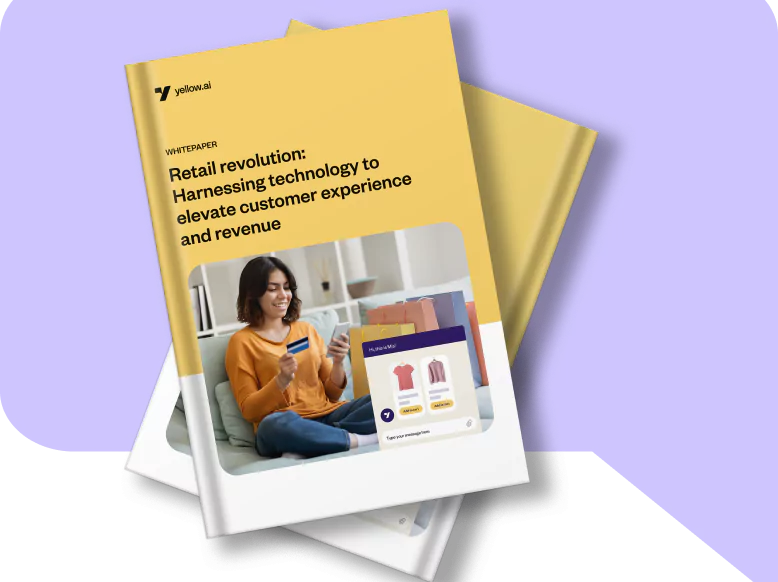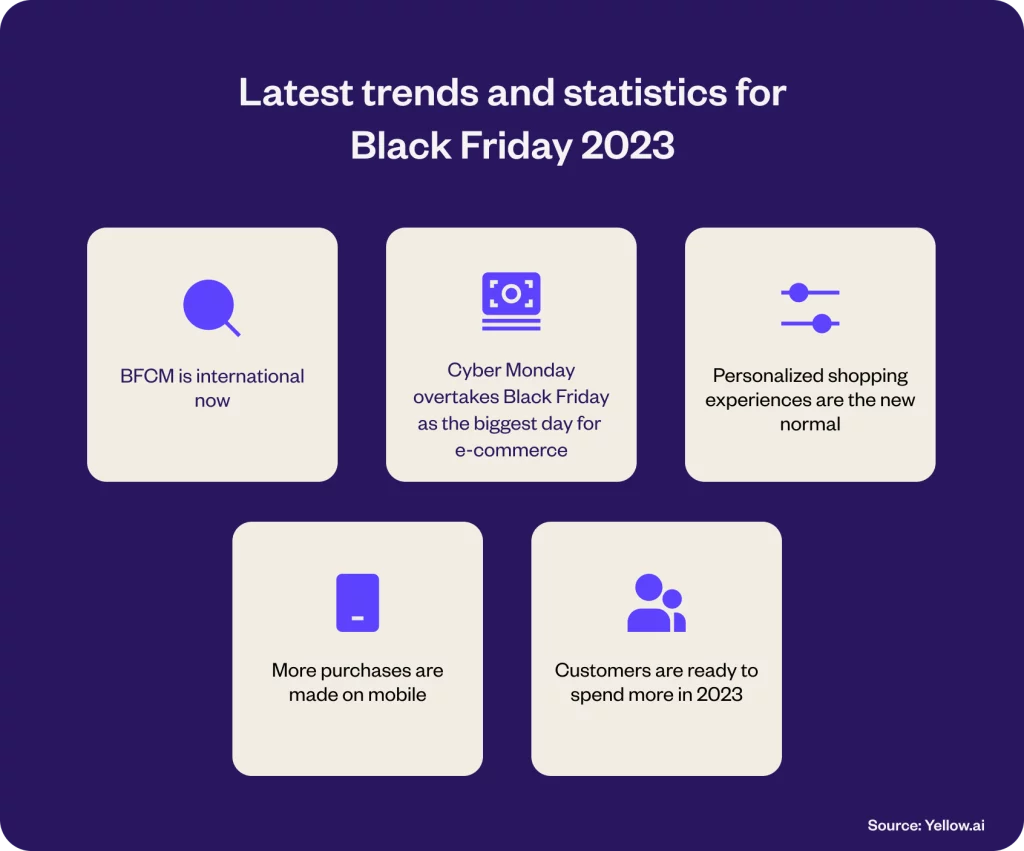The countdown to Black Friday and Cyber Monday (BFCM) is on! With 2023 flying by and the holiday season around the corner, it’s prime time for you to amp up your sales, skyrocket your revenue, and stand tall as a leader in the retail world.
There’s no doubt that the retail game has kept evolving over the last few years: The pandemic, tangled supply chains, and a fluctuating global economy have all led to shopping undergoing a complete makeover.
The surge in online shopping isn’t a temporary trend; it’s our new reality. With a whopping $9.12 billion spent in online sales on Black Friday alone last year (Adobe Analytics report), all signs are pointing to an even bigger wave for Black Friday 2023
So how can you capitalize on this opportunity? In this blog, we’ll dive into the latest retail trends, challenges, and strategies that you can use to turn this BFCM into your biggest win yet.
E-guide – AI retail bots to drive more sales with lesser resources

Latest trends and statistics for Black Friday 2023
1. BFCM is international now
Black Friday and Cyber Monday may have originated in the US as an American tradition, but it’s now celebrated globally as one of the biggest retail days of the year. According to Shopify, Canada and the UK have the highest sales, just after the US.
So, even if your business is not based or operating in the United States, don’t miss out on the opportunity to capture the shopping surge by Black Friday and Cyber Monday deals.
2. Cyber Monday overtakes Black Friday as the biggest day for e-commerce
According to Adobe, Cyber Monday 2022 surpassed the Black Friday record to set a new benchmark for e-commerce retailers with a whopping $11.3 billion.
The reason? Cyber Monday extends the shopping timeframe, allowing consumers greater flexibility to conduct product research, price comparisons, and make thoughtful purchasing choices.Who wouldn’t like beating the Monday blues with some retail therapy!
So a good approach would be to space out your offers, starting from Black Friday and then leading up to your most appealing discounts for Cyber Monday.
3. Personalized shopping experiences are the new normal
According to Statista’s 2022 findings, when it comes to online purchases made by consumers from different countries over the past six months, 89% of marketers have observed a favorable return on investment (ROI) when they incorporate personalization into their campaigns.
During the Black Friday season, many e-commerce retailers implement pre-conceived marketing strategies. As a result, there is an abundance of discount offers available to customers from other retailers. There’s a higher chance that customers might overlook your site if your offerings are not particularly remarkable.
Personalized messaging ensures a unique shopping experience that’s tailored for each customer, leaving a positive impact and increasing brand loyalty.
4. More purchases are made on mobile
During Black Friday and Cyber Monday, the number of purchases made from mobile phones is higher as compared to desktops. According to Shopify, In 2022, 73% of sales for merchandise on their platforms were made by mobile.
However, this trend varies throughout the BFCM. In a report by Adobe, it is shown that 55% of sales come from mobile on Thanksgiving (people celebrate with family and friends at home and not using desktop computers ) and 43% on Cyber Monday (people start moving to office and shop on desktop)
Make sure that your website is optimized for both mobile and desktop shopping experience. Moreover, the chatbot is available on both devices to cater to customer service requests.
5. Customers are ready to spend more in 2023
There’s no doubt that BFCM is the biggest weekend for retail. Shopify has found that the average order total on Black Friday and Cyber Monday has seen an upward trend over the years. With over $20 billion being splurged in 2022, it’s very likely that BFCM 2023 is poised to break that record and be the biggest one yet.

Preparing for BFCM 2023: Addressing the challenges
It’s clear that we’re all set for a record-breaking season. However, success isn’t without its hurdles. Here’s an insightful look at the challenges that you, as e-commerce leaders, might encounter and how you can take strategic steps to overcome them.
1. Not choosing solutions that solve for scale
Black Friday’s global footprint is expanding, but many retailers are still playing catch-up with the tech that can handle the heat. Making investments in a unified platform with CRM integration isn’t a luxury; it’s a necessity.
2. Lack of 24*7 customer assistance
During BFCM, a surge in order volumes and customer inquiries is a given. Retailers must ensure their customer support is seamless and responsive, mitigating long wait times and ensuring efficient resolution of queries, which can otherwise lead to customer service bottlenecks.
3. Limited personalization
Delivering a tailored shopping experience to each customer during Black Friday’s rush is a formidable challenge. Without advanced analytics and AI-powered tools to provide personalized recommendations, your customers are up for a subpar shopping experience, thus leading to cart abandonments and lost revenue.
4. Inconsistent experience across multiple channels
When customers come knocking on all channels, delivering an omnichannel experience that is smooth and consistent is pivotal. Retailers will need to navigate through data silos and optimize their workforce to ensure consistency and quality of service across all customer touchpoints.
5. Data and privacy issues
The increased BFCM traffic can put data at risk. Retailers must fortify their defenses with secure payment gateways, robust access controls, and encryption to safeguard customer information against breaches.
These challenges are significant, but not insurmountable. With strategic planning and the right technological toolkit, retailers can excel during BFCM 2023, ensuring a profitable and brand-enhancing customer experience.
Revolutionize retail experiences with Generative AI
As the BFCM horizon approaches, generative AI stands as a cornerstone for retailers aspiring to lead in conversational commerce. This transformative technology offers seamless integration into existing systems, paving the way for 24/7 automated customer service that’s not just responsive but predictive, providing personalized shopping experiences at scale. With the ability to handle a high volume of interactions across multiple channels, generative AI ensures consistency and personalization, turning every customer interaction into an opportunity to solidify relationships and boost sales.
The strategic application of generative AI extends beyond customer-facing interfaces; it revolutionizes backend operations by enhancing data analysis, securing transactions, and predicting market trends. Retailers are equipped with the insights needed for precision inventory management and tailored marketing strategies, ensuring that they are not just prepared for the surge of BFCM but are also setting trends in customer engagement.
Conclusion
In this ever-changing world of e-commerce, Black Friday and Cyber Monday are a golden chance for your brand to excel. As we have discussed all the essential aspects of Black Friday 2023, one aspect that remains rock-solid, and everything boils down to it, is your customer’s experience.
Wish to learn more about how generative AI-powered shopping experiences are shaping the future of conversational commerce? Join us for an exclusive LinkedIn live.























